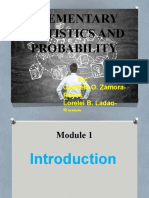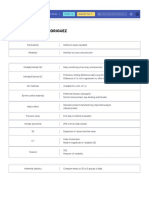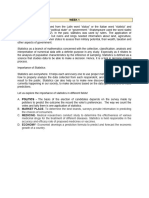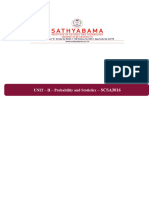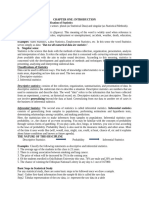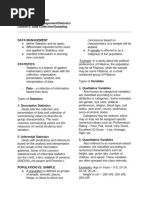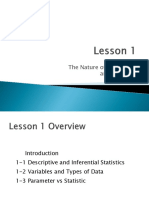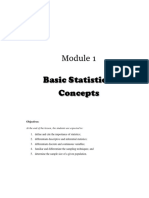Week 1 Intro To Statistics and Level of Measurement
Uploaded by
azinWeek 1 Intro To Statistics and Level of Measurement
Uploaded by
azinMODULE 1
Introduction to Statistics and Level of
Measurements
Subject Objectives
At the end of this lesson, the learners should be able to:
• Understand the key concept of statistics and the two fields of statistics
• Identify questions that could be answered using a statistical process.
• Define universe and differentiate it with population;
• Define and differentiate between qualitative and quantitative variables, and between
discrete and continuous variables (that are quantitative); and
• Define the Levels of Measurement of Numerical Data.
Start-up Activity
Describe if the question can be answered directly or it requires gathering of information to
produce answer. Write YES if can be answered directly and NO if does not. Write your answer
in the space provided.
________1. What is a typical size of a Filipino family?
________2. How many hours in a day?
________3. How old is the oldest man residing in the Philippines?
________4. Is planet Mars bigger than planet Earth?
________5. What is the average wage rate in the country?
________6. Would Filipinos prefer eating bananas rather than apple?
________7. How long did you sleep last night?
________8. How much a newly-hired public school teacher in NCR earns in a month?
________9. How tall is a typical Filipino?
________10. Did you eat your breakfast today?
Statistics and Probability
Year Revised: 2020 Page 1 of 6
Subject Content
Probability
• It is a mathematical concept used to measure the occurrence of statistical events.
• It is the chance of a certain event will occur or happen.
Statistics
• A science that studies data to be able to make a decision.
• A science involves the methods of collecting, processing, summarizing and analyzing
data in order to provide answers or solutions to an inquiry.
• It is a branch of mathematics that deals with the processes of gathering, describing,
organizing, analyzing and interpreting numerical or statistical data as well as with
drawing valid conclusions and making reasonable decisions on the basis of such
analysis. Such data may be in the field of education, social sciences, medicine,
engineering, business, agriculture, economics, and other areas.
Trivia: The word “statistics” actually comes from the word “state”— because
governments have been involved in the statistical activities, especially the conduct of
censuses either for military or taxation purposes.
Statistics as a Tool in Decision-Making it enable us to:
• Characterize persons, objects, situations, and phenomena;
• Explain relationships among variables;
• Formulate objective assessments and comparisons; and, more importantly
• Make evidence-based decisions and predictions.
Fields of Statistics
• Descriptive Statistics
Which is concerned to the collection and description of a set of data to yield
meaningful information. Descriptive statistics provides information only about
collected data and does not draw inferences or conclusions about a larger set of data.
This type of statistics will be used only when one would like to describe a
group of individuals or describe the data that have been collected; to make a
description of variables that were categorized in order to determine the measure of a
certain dependent variable that is to be measured. In general, this type of statistics is
devoted to summarization and description of data set.
• Inferential Statistics
Which is composed of those methods concerned with the analysis of a smaller
group of data, which is known as the sample leading to predictions or inferences
about the larger set of data, or the population from which the sample is drawn.
This type of statistics will be used when one makes a decision, estimates
prediction or generalization about a population based on a sample. There are two
types of tests in an inferential statistic the Parametric Test and the Non – Parametric
Test.
Statistics and Probability
Year Revised: 2020 Page 2 of 6
Definition of Basic Terms
• Universe - The collection or set of units or entities from whom we got the data.
• Variable - Is a characteristic that is observable or measurable in every unit of the
universe.
• Population - set of all possible values of a variable.
• Sample - A subgroup of a universe or of a population.
Broad Classification of Variables
• Qualitative variables - Express a categorical attribute, such as sex (male or female),
religion, marital status, region of residence, highest educational attainment.
Qualitative variables do not strictly take on numeric values (although we can have
numeric codes for them, e.g., for sex variable, 1 and 2 may refer to male, and female,
respectively). Qualitative data answer questions “what kind.” Sometimes, there is a
sense of ordering in qualitative data, e.g., income data grouped into high, middle and
low-income status. Data on sex or religion do not have the sense of ordering, as there
is no such thing as a weaker or stronger sex, and a better or worse religion. Qualitative
variables are sometimes referred to as categorical variables.
• Quantitative (otherwise called numerical) variable - whose sizes are meaningful,
answer questions such as “how much” or “how many”. Quantitative variables have
actual units of measure. Examples of quantitative variables include the height,
weight, number of registered cars, household size, and total household
expenditures/income of survey respondents. Quantitative data may be further
classified into:
o Discrete data:
Those data that can be counted, e.g., the number of days for cellphones
to fail, the ages of survey respondents measured to the nearest year, and the
number of patients in a hospital. These data assume only (a finite or infinitely)
countable number of values.
These are the variables whose values or levels cannot take the form of
decimals. These are the variables that data can be taken through the process
of enumeration or counting. An example is the size of a particular family, since
it can only take a specific value such as 1, 2, 3, 4 and so on. Values between
them like 1.5 or 3.2 are not possible. We cannot have a family with 5.5
members.
o Continuous data:
Those that can be measured, e.g. the exact height of a survey
respondent and the exact volume of some liquid substance.
These are the variables whose levels can take continuous values or
assume a continuous set of numerical values. Examples are height, weight,
length, width and temperature. With these variables you can make
measurements of varying degrees of precision.
Statistics and Probability
Year Revised: 2020 Page 3 of 6
Levels of Measurement of Numerical Data
Statistics being a mathematical subject will be dealing with mostly numeric
information. This numeric data would be classified in accordance to the purpose and
type of data being handled.
a. Nominal Data – are commonly categorical data assigned to numbers. In this
data type, counting the number of times a certain data would fall on the
category would only be the applicable measurement. Example of which is
assigning 1 for males and 2 for females. Data that can be categorized as
nominal data include course, civil status, color, preference, etch.
b. Ordinal Data – are quantities where the numbers are used to designate the
rank order of the data. In this type, the correlation or the effect ranking of one
variable to another can be measured. However, the range for each rank is not
constant. Examples of quantities that use this level of measurement are the
result of a race, ranking of beauty pageant, educational attainment, etch.
c. Interval Data – is a data type where the range between the numeric values is
constant. In this data type addition and subtraction of values can be
performed, however, multiplication and division is not appropriate. Example
if for instance we would like to determine the information on describing the
level of the academic performance of students in mathematics or academic
performance of students: the intervals using the mean form a point scale from
which the lowest point is 1 and the highest point is 5 as follows: 1.00 – 1.49
Poor; 1.50 – 2.49 Needs Improvement; 2.50 – 3.49 Satisfactory; 3.50 – 4.49
Very Satisfactory; and 4.50 – 5.00 Outstanding.
d. Ratio Data – are the widely used data in science and engineering. Like the
interval measurements are also expressed in numbers, and the difference
between the two any successive numbers are consistent. It has, however, the
addition characteristics of starting from a true zero. Example of this length,
mass, angles, charge, energy, relative frequency, velocity, etch.
Statistics and Probability
Year Revised: 2020 Page 4 of 6
Self-Reflection
Encircle
your
answer
FORM
Read each statement and check ( ) the box that reflects your work
today.
Name: Date:
Section:
Strongly Strongly
Agree Disagree
Agree Disagree
1. I found this work interesting.
2. I make a strong effort.
3. I am proud of the results.
4. I understood all the
instructions.
5. I followed all the steps.
6. I learned something new.
7. I feel ready for the next
assignment.
www.ldatschool.ca/executive-function/self-assessment/
Statistics and Probability
Year Revised: 2020 Page 5 of 6
Self-Assessment
I. Classify the following variables as to qualitative or quantitative and further more as
to discrete or continuous.
Variable Type of Variable Type of Quantitative Variable
Class Student Number
Sex
Number of Siblings
Weight (in kilograms)
Height (in centimeters)
II. Classify the Levels of Measurement of Numerical Data of following variables.
Variable Levels of Measurement of Numerical Data
Class Student Number
Sex
Number of Siblings
Weight (in kilograms)
Height (in centimeters)
Statistics and Probability
Year Revised: 2020 Page 6 of 6
You might also like
- Elementary Statistics and Probability: By: Carmela O. Zamora-Reyes Lorelei B. Ladao - Saren100% (2)Elementary Statistics and Probability: By: Carmela O. Zamora-Reyes Lorelei B. Ladao - Saren27 pages
- MUST TO KNOW CC RODRIGUEZ Flashcards - QuizletNo ratings yetMUST TO KNOW CC RODRIGUEZ Flashcards - Quizlet32 pages
- 1_Nature of Statistics_SMM105_Elementary Statistics and Probability_2ndSem (20250203163205)No ratings yet1_Nature of Statistics_SMM105_Elementary Statistics and Probability_2ndSem (20250203163205)12 pages
- 'MATH 233 Statistics for Social Sciences_Week 1' D_241029_161224No ratings yet'MATH 233 Statistics for Social Sciences_Week 1' D_241029_161224110 pages
- Math as a Tool Data Management Introduction and Central TendencyNo ratings yetMath as a Tool Data Management Introduction and Central Tendency12 pages
- Statistics and Probability Handouts - Basic Terms in StatisticsNo ratings yetStatistics and Probability Handouts - Basic Terms in Statistics4 pages
- Data Processing and Presentation: Joycee D. LoquiteNo ratings yetData Processing and Presentation: Joycee D. Loquite40 pages
- The Nature of Probability and StatisticsNo ratings yetThe Nature of Probability and Statistics30 pages
- Module1-Basic Statistical Concepts (Business)No ratings yetModule1-Basic Statistical Concepts (Business)15 pages
- Chapter 1-2 Basic Stat.docx NEW (1) (1)No ratings yetChapter 1-2 Basic Stat.docx NEW (1) (1)15 pages
- Mathematics As A Tool: at The End of The Fourth Module, You Must HaveNo ratings yetMathematics As A Tool: at The End of The Fourth Module, You Must Have5 pages
- PSY 320 L1 Introduction to Educational StatisticsNo ratings yetPSY 320 L1 Introduction to Educational Statistics5 pages
- Numerical Findings Relevant To A Business Decision or Situation. Because of The Diversity ofNo ratings yetNumerical Findings Relevant To A Business Decision or Situation. Because of The Diversity of12 pages
- Microchip MCP7940M Low Cost I2C Real Time Clock Calendar With SRAMNo ratings yetMicrochip MCP7940M Low Cost I2C Real Time Clock Calendar With SRAM39 pages
- Python For Reservoir Engineering and SurveillanceNo ratings yetPython For Reservoir Engineering and Surveillance7 pages
- Grade 8 Study List Term 3 Final Exam ZehranNo ratings yetGrade 8 Study List Term 3 Final Exam Zehran11 pages
- Stephanie Paladino (Editor), Shirley J Fiske (Editor) - The Carbon Fix - Forest Carbon, Social Justice, and Environmental Governance-Routledge (2016)No ratings yetStephanie Paladino (Editor), Shirley J Fiske (Editor) - The Carbon Fix - Forest Carbon, Social Justice, and Environmental Governance-Routledge (2016)356 pages
- 34 WaterScienceandTechnology2013 duPisaniMengeNo ratings yet34 WaterScienceandTechnology2013 duPisaniMenge15 pages
- Method Statement For Fire Alarm System Installation100% (1)Method Statement For Fire Alarm System Installation4 pages
- Economic Methodology Is The Study of MethodsNo ratings yetEconomic Methodology Is The Study of Methods18 pages
- Airbus a330 Flight Crew Operating Manual Vol 3No ratings yetAirbus a330 Flight Crew Operating Manual Vol 3793 pages
- MDE-4868F Fuel Point PLUS Vehicle Installation - Anillos y DatapassNo ratings yetMDE-4868F Fuel Point PLUS Vehicle Installation - Anillos y Datapass132 pages
- Qureshi Et Al. 2014 An Empirical Relationship Between In-Situ Permeability and RQD of Discontinuous Sedimentary Rocks PDFNo ratings yetQureshi Et Al. 2014 An Empirical Relationship Between In-Situ Permeability and RQD of Discontinuous Sedimentary Rocks PDF10 pages
- Test Pentru Admiterea in Clasa A V-A Engleza Intensiv: - IUNIE 2019No ratings yetTest Pentru Admiterea in Clasa A V-A Engleza Intensiv: - IUNIE 201917 pages
- Active Structural Control: Abstract This Chapter Provides An Overview of Building Structure Modeling andNo ratings yetActive Structural Control: Abstract This Chapter Provides An Overview of Building Structure Modeling and37 pages
- Anatomy & Physiology of Respiratory SystemNo ratings yetAnatomy & Physiology of Respiratory System37 pages
- Elementary Statistics and Probability: By: Carmela O. Zamora-Reyes Lorelei B. Ladao - SarenElementary Statistics and Probability: By: Carmela O. Zamora-Reyes Lorelei B. Ladao - Saren
- 1_Nature of Statistics_SMM105_Elementary Statistics and Probability_2ndSem (20250203163205)1_Nature of Statistics_SMM105_Elementary Statistics and Probability_2ndSem (20250203163205)
- 'MATH 233 Statistics for Social Sciences_Week 1' D_241029_161224'MATH 233 Statistics for Social Sciences_Week 1' D_241029_161224
- Math as a Tool Data Management Introduction and Central TendencyMath as a Tool Data Management Introduction and Central Tendency
- Statistics and Probability Handouts - Basic Terms in StatisticsStatistics and Probability Handouts - Basic Terms in Statistics
- Data Processing and Presentation: Joycee D. LoquiteData Processing and Presentation: Joycee D. Loquite
- Mathematics As A Tool: at The End of The Fourth Module, You Must HaveMathematics As A Tool: at The End of The Fourth Module, You Must Have
- Numerical Findings Relevant To A Business Decision or Situation. Because of The Diversity ofNumerical Findings Relevant To A Business Decision or Situation. Because of The Diversity of
- Descriptive Statistics: Six Sigma Thinking, #3From EverandDescriptive Statistics: Six Sigma Thinking, #3
- Microchip MCP7940M Low Cost I2C Real Time Clock Calendar With SRAMMicrochip MCP7940M Low Cost I2C Real Time Clock Calendar With SRAM
- Stephanie Paladino (Editor), Shirley J Fiske (Editor) - The Carbon Fix - Forest Carbon, Social Justice, and Environmental Governance-Routledge (2016)Stephanie Paladino (Editor), Shirley J Fiske (Editor) - The Carbon Fix - Forest Carbon, Social Justice, and Environmental Governance-Routledge (2016)
- Method Statement For Fire Alarm System InstallationMethod Statement For Fire Alarm System Installation
- MDE-4868F Fuel Point PLUS Vehicle Installation - Anillos y DatapassMDE-4868F Fuel Point PLUS Vehicle Installation - Anillos y Datapass
- Qureshi Et Al. 2014 An Empirical Relationship Between In-Situ Permeability and RQD of Discontinuous Sedimentary Rocks PDFQureshi Et Al. 2014 An Empirical Relationship Between In-Situ Permeability and RQD of Discontinuous Sedimentary Rocks PDF
- Test Pentru Admiterea in Clasa A V-A Engleza Intensiv: - IUNIE 2019Test Pentru Admiterea in Clasa A V-A Engleza Intensiv: - IUNIE 2019
- Active Structural Control: Abstract This Chapter Provides An Overview of Building Structure Modeling andActive Structural Control: Abstract This Chapter Provides An Overview of Building Structure Modeling and
